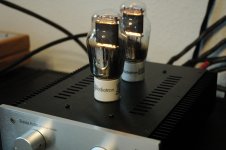So what's the difference other than the obvious visible shade difference? Is there an audible difference, or is it more of indicator of something like plant location, age, series, etc?
Its the chemical difference in the carbon structure used for the plate surface coating.
Tube sound is mostly chemicals. So different chemicals being used result in different sound.
Don't know which tubes you refer to.
Tube sound is mostly chemicals. So different chemicals being used result in different sound.
Don't know which tubes you refer to.
I read about it once in a book about tube design by RCA.
If I remember correctly, the black color is from a carbon coating. The black radiates energy better, so allows for a little more plate dissipation. However, it also traps more stray gas molecules and requires more time heating up the tube internal structure with induction coils and running the vacuum pump during manufacturing.
So the black coating is a good feature to have but increased manufacturing costs in time and electrical energy for the additional heating.
I wouldn't expect a difference in sound from the coating itself, but the black coating indicates that the manufacturer was at least trying to make a top-quality tube.
If I remember correctly, the black color is from a carbon coating. The black radiates energy better, so allows for a little more plate dissipation. However, it also traps more stray gas molecules and requires more time heating up the tube internal structure with induction coils and running the vacuum pump during manufacturing.
So the black coating is a good feature to have but increased manufacturing costs in time and electrical energy for the additional heating.
I wouldn't expect a difference in sound from the coating itself, but the black coating indicates that the manufacturer was at least trying to make a top-quality tube.
Its the chemical difference in the carbon structure used for the plate surface coating.
Tube sound is mostly chemicals. So different chemicals being used result in different sound.
Don't know which tubes you refer to.
It was a set of RCA 12BH7s that got me thinking about it. I have two gray and one black.
Found this patent on the topic of carbon anode plating:
"A vacuum tube having its anode/collector coated with carbonized resin plus pyrocarbon material to reduce out-gassing and secondary electron emission and the method of coating the anode/collector."
US6856080B2 - Carbonized resin coated anode
- Google Patents
"A vacuum tube having its anode/collector coated with carbonized resin plus pyrocarbon material to reduce out-gassing and secondary electron emission and the method of coating the anode/collector."
US6856080B2 - Carbonized resin coated anode
- Google Patents
Last edited:
I'm in love with graphite anode 801 (TT filament). 🙂Oh, and did I mention Thoriated Tungsten (Thorium and Wolfram).
Unfortunately nowadays you have to rob a bank to buy a good pair. :-(
Attachments
Its the chemical difference in the carbon structure used for the plate surface coating.
Tube sound is mostly chemicals. So different chemicals being used result in different sound.
Don't know which tubes you refer to.
Tube sound is mostly Child's law, space-charge dynamics and electrode geometry - yes coatings can affect emission and secondary emission, but that's not the main factor in response curves for most devices. Of course gas-filled tubes are very different, and exotic secondary-emission tubes exist like EF50.
You said it- its all about the geometry! Or maybe three quarters of the sound. Who knows?
An excellent tube design needs one thing in favor: space! Thats the reason why most designs of the later all glass generations have worsen the transfer functions in comparison to earlier types.
But that didn't worry anymore- you can correct it with neg. feedback!
What is a burglary against a bank against the establishment of a bank?
An excellent tube design needs one thing in favor: space! Thats the reason why most designs of the later all glass generations have worsen the transfer functions in comparison to earlier types.
But that didn't worry anymore- you can correct it with neg. feedback!
What is a burglary against a bank against the establishment of a bank?
Last edited:
As long as you can make it stable, lots of negative feedback can cover up all kinds of bad parts and bad circuit topologies.
That is one difficult way to design an amp.
Use good parts, and good topologies, and make it easier.
As long as you have good enough parts, and good enough topology, you can make a very good amplifier without negative feedback.
And doing it that way is also one difficult way to design an amp.
Both methods above have their successes and their failures.
And OH!
Those Carbon Plate 801 tubes are beautiful!
That is one difficult way to design an amp.
Use good parts, and good topologies, and make it easier.
As long as you have good enough parts, and good enough topology, you can make a very good amplifier without negative feedback.
And doing it that way is also one difficult way to design an amp.
Both methods above have their successes and their failures.
And OH!
Those Carbon Plate 801 tubes are beautiful!
Last edited:
- Home
- Amplifiers
- Tubes / Valves
- Black Plate vs Gray Plate
